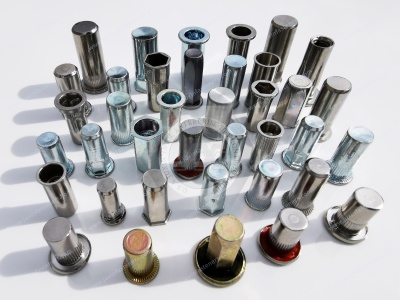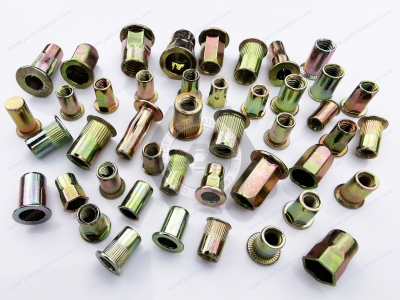Call Us
+86 136 6007 9809
Call Us
+86 136 6007 9809
Nov. 14, 2023
A closed-end rivet Nut is a commonly used connecting fastener in various industrial machinery equipment and structures. It is simple, convenient, and reliable, can quickly complete the connection fastening operation, and improves production efficiency. This article will introduce the specifications of the closed-end rivet nut and its use in detail. Thread-Sealing Closed-End Rivet Nuts: The thread area is enclosed, which prevents leakage past the threads from either side of your application. These rivet nuts have a ribbed body to hold them in place when tightening a screw. The body and flange are zinc yellow-chromate plated steel for corrosion resistance. Install in a drilled hole using a rivet nut tool. The tool collapses the nut, creating a backside flange that holds the nut to the material. Length is measured from under the flange. Installed length is the maximum length of the barrel when installed.
Definition of closed-end rivet nuts:The closed-end rivet nut is a specially designed connection element that can be installed when operating from the other side is impossible. It usually consists of a metal sleeve with internal threads and an external rotatable pull rod. The connection with different parts can be achieved by inserting the closed-end rivet nut into the pre-drilled hole and tightening the tie rod.
Closed-end rivet nut specifications:
1. Size: The size of the closed-end rivet nut varies according to different application requirements. Its diameter ranges from M3 to M12, and its length ranges from 10mm to 30mm. The specific size can be customized according to actual needs.
2 Material: The closed-end rivet nut's material is usually high-quality stainless steel or carbon steel. Stainless steel has good corrosion resistance and is suitable for humid or high-temperature environments. Carbon steel has high strength and hardness and is ideal for connections in general mechanical structures.
3 Surface treatment: It is often surface-treated to improve the closed-end rivet nut's surface quality and corrosion resistance. Joint surface treatment methods include nickel plating, electro galvanizing, hot dip galvanizing, nickel alloy, black zinc, electroplating aluminum, etc. These treatment methods can effectively extend the service life of the closed-end rivet nut and improve its appearance quality. Third, the use of closed-end rivet nuts
4. Drilling: Before using the closed-end rivet nut, drill holes in the connecting parts. The diameter of the drilling hole should match the diameter of the closed-end rivet nut to ensure the stability of the connection.
5. Installation: Insert the rivet nut with a closed-end into the pre-drilled hole, ensuring sufficient clearance between the nut and the hole wall. Then, rotating the tie rod, tighten the nut until it is tightly connected to the other parts.
6. Disassembly: If you need to remove the closed-end rivet nut, reverse-rotate the rod. Before loosening the nut, ensure the tie rod is loose to avoid unnecessary damage.


Advantages of closed-end rivet nuts:
1 Convenient and quick: The closed-end rivet nut can be installed without being able to be operated from the other side. This makes it easier and faster to connect in tight Spaces or unique environments.
2 High-strength connection: The closed-end rivet nut adopts an internal and external linkage design, which can provide higher connection strength. It can withstand large loads and maintain a stable and reliable connection.
3 Reuse: Closed-end rivet nuts can be reused compared to disposable connected components. Loosen the tie rod and remove the nut to reinstall it elsewhere.
Application field:Closed-end rivet nuts are widely used in various mechanical equipment and structures. For example, automotive manufacturing, aerospace, electronic equipment, and other industries must use closed-end rivet nuts for connection. They can be used to fix seats, install instruments, connect metal plates, etc.
The closed-end rivet nut is essential in various industries as a common connection element. This paper introduces closed-end rivet nuts' specifications and application methods, including dimensions, materials, surface treatment, etc. At the same time, the advantages of its convenience and broad application fields are emphasized. The reliability and efficiency of the connection can be improved by reasonable selection and correct use of closed-end rivet nuts. Please contact:Adelajonly@gmail.com
Contact Us
Tel.:
+86 020 8621 0320
+86 020 3121 6067
E-mail:
Technical Support:
Navigation
SEND INQUIREY